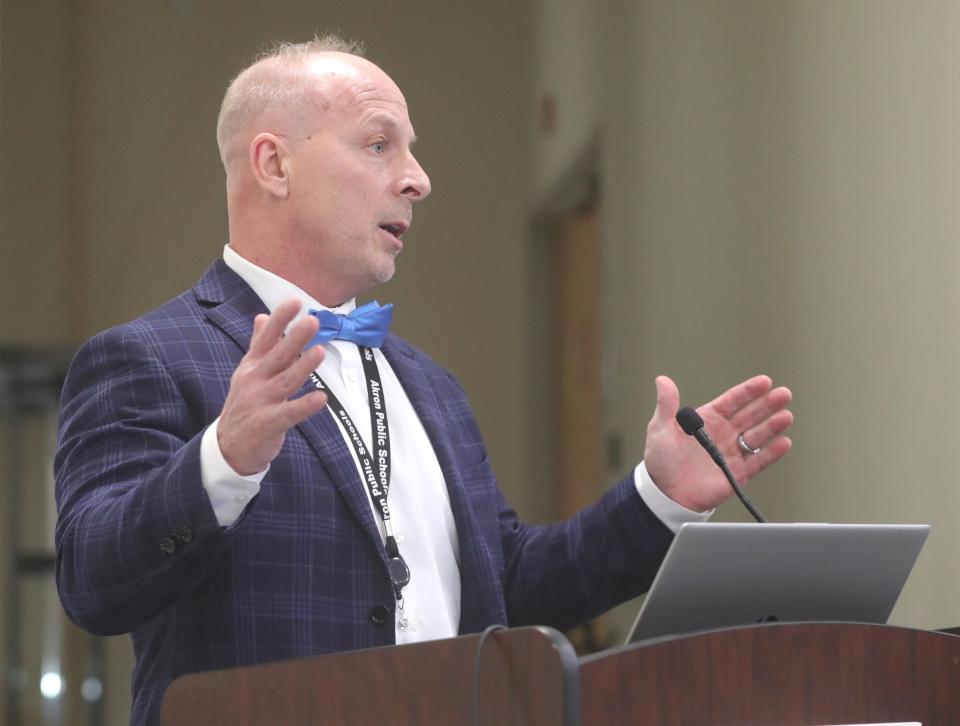Akron Public Schools board approves idea of $15 million in cuts, about 4% of budget
The Akron Public Schools board intends to approve $15 million of cuts in the next year, about 4% of the district's annual budget.

The board on Monday approved a five-year forecast that pledges the district will cut that much from the budget before the next fiscal year, which starts in July.
The board also discussed adding a levy to the March primary ballot. They did not vote to do so, but several board members said they would support that ask.
Through the discussion of the finances and a possible levy, board members and administrators worked to thread a needle, trying to tamp down panic over the district's finances — which will soon be presented to a bond rating agency to issue the district's first credit rating in years — while also preparing to ask the citizens of Akron for more money.
"So we are in solid financial shape, but we're also levy imminent," APS Chief Financial Officer Stephen Thompson said.
Thompson presented the forecast, which, with the cuts included, would have the district in the black by about $9 million next year, but spending at a deficit the following year.
Thompson had previously told the board that a cut of $15 million was necessary in addition to passing a levy in order for the district to be fiscally sustainable.
Still, Thompson stressed the cuts were "a small percentage" of the budget that could be achieved "simply by right sizing each year through attrition" due to declining enrollment. He also said programs could be cut if the district happens to have two programs that do the same thing.
"So there are multiple ways to address this, but it should not send concern to anyone," Thompson said. "But it is pivotal that we make these reductions to stay fiscally solvent, the way that we we want to operate, which is in black through all five years."
The administration has not presented a plan for how to achieve the $15 million in cuts in the next year, but it has stressed the majority of the district's budget is salaries and healthcare costs.
The five-year forecast, per state law, cannot include any levies that voters have yet to approve, so the forecast approved Monday night does not include the assumption of a new levy, despite the likelihood the board will seek one.
Thompson noted several factors that have or will hit the district hard financially, including predictions for declining enrollment based on population trajectories and the ending of federal pandemic relief money. The last dollars from the American Rescue Plan Act's Elementary and Secondary School Emergency Relief fund, of which Akron received nearly $100 million, must be spent by September 2024.
The district also took on significantly increased costs for personnel with the agreement of increases to union contracts over the next three years that will cost the district an extra $4.78 million this year, $9.72 million next year and just over $16 million the following year.
Still, the district has not passed a levy since 2013 and will not benefit from the increasing property values following the recent reassessment in Akron. That's thanks to a 1970s law called House Bill 920.
When property values go up, state law allows local governments and schools to collect more money on only a portion of levies — the portion residents don't vote on, including 10 "inside mills" for local governments and a "20-mill floor" for school districts. House Bill 920, which passed in 1976, freezes the amount that the rest of the levies can collect. If property values go up, HB 920 forces the effective millage rate to go down so not a penny more is collected than when voters approved their levies for a set total of money over a certain period of time.
Thompson explained the state will also lower the amount of funding it contributes to Akron's budget because property values in the district increased, even if that doesn't benefit the district until voters approve a new levy.
The board Monday did not discuss what millage they would ask for on a levy in March or November of next year, but several board members spoke in favor of a levy request coming as early as March.
"We say oftentimes... that as APS goes, so goes the city of Akron," Board President Derrick Hall said. "Where the rubber meets the road, there is passage of levies."
Hall said he would also ask the board to consider the possibility of adding a second permanent improvement levy that would fund a new building for North High School.
The board voted this summer to build a new school in the Kenmore neighborhood. That will require taking on debt, which is why the district is seeking a bond rating. But the debt it would take to build a new North as well, without a funding source to offset it, was not feasible, district leaders said at the time.
The five-year forecast approved Monday night does include the debt payments, anticipated at around $3 million a year, to build the new school in Kenmore to house Pfeiffer Elementary, which would be closed, and the relocated Miller South School for the Visual and Performing Arts.
The forecast also makes the assumption that the district will close Firestone Park Elementary and two early learning centers, whose classes would be all be relocated into other schools.
Contact education reporter Jennifer Pignolet at jpignolet@thebeaconjournal.com, at 330-996-3216 or on Twitter @JenPignolet.
This article originally appeared on Akron Beacon Journal: Akron Public Schools board approves forecast with $15 million in cuts
